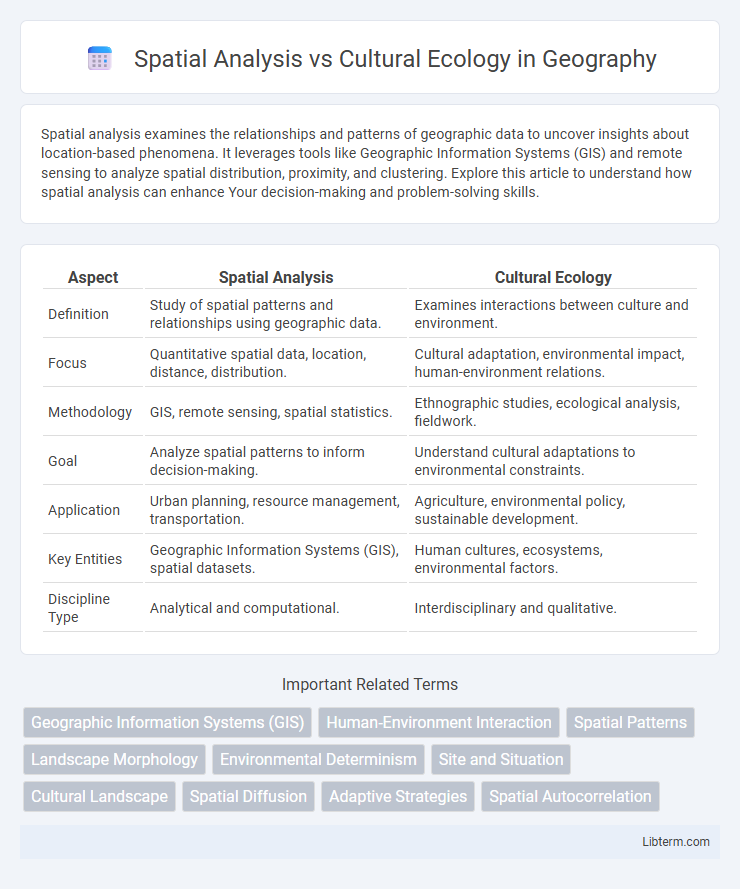Spatial analysis examines the relationships and patterns of geographic data to uncover insights about location-based phenomena. It leverages tools like Geographic Information Systems (GIS) and remote sensing to analyze spatial distribution, proximity, and clustering. Explore this article to understand how spatial analysis can enhance Your decision-making and problem-solving skills.
Table of Comparison
| Aspect | Spatial Analysis | Cultural Ecology |
|---|---|---|
| Definition | Study of spatial patterns and relationships using geographic data. | Examines interactions between culture and environment. |
| Focus | Quantitative spatial data, location, distance, distribution. | Cultural adaptation, environmental impact, human-environment relations. |
| Methodology | GIS, remote sensing, spatial statistics. | Ethnographic studies, ecological analysis, fieldwork. |
| Goal | Analyze spatial patterns to inform decision-making. | Understand cultural adaptations to environmental constraints. |
| Application | Urban planning, resource management, transportation. | Agriculture, environmental policy, sustainable development. |
| Key Entities | Geographic Information Systems (GIS), spatial datasets. | Human cultures, ecosystems, environmental factors. |
| Discipline Type | Analytical and computational. | Interdisciplinary and qualitative. |
Introduction to Spatial Analysis and Cultural Ecology
Spatial analysis utilizes geographic data and quantitative techniques to examine patterns, relationships, and processes in the spatial distribution of phenomena. Cultural ecology investigates how human cultures adapt to environmental conditions, emphasizing the interactions between cultural practices and ecological constraints. Both fields integrate geographic information but differ in focus, with spatial analysis prioritizing measurable spatial patterns, while cultural ecology centers on cultural-environmental dynamics.
Defining Spatial Analysis: Concepts and Applications
Spatial analysis involves examining the locations, attributes, and relationships of features in geographic space to identify patterns and trends. It utilizes tools like Geographic Information Systems (GIS), spatial statistics, and remote sensing to analyze data for urban planning, environmental management, and resource allocation. This methodology enables researchers to understand spatial distributions and interactions, supporting decision-making across various disciplines.
Exploring Cultural Ecology: Principles and Key Theories
Cultural ecology examines how cultural practices adapt to environmental challenges, emphasizing the dynamic interaction between societies and their ecosystems through principles such as adaptation, cultural core, and ecosystem approach. Key theories include Julian Steward's cultural core concept, highlighting economic and technological bases of culture shaped by environment, and Roy Rappaport's systems ecology, which explores regulatory feedback mechanisms in cultural practices. This interdisciplinary approach integrates anthropology, geography, and ecology to analyze human-environment relationships beyond spatial distribution, focusing on cultural responses to environmental constraints and opportunities.
Historical Evolution of Both Approaches
Spatial Analysis originated in the mid-20th century with advances in geographic information systems (GIS) and quantitative methods, emphasizing spatial patterns and relationships in geographic data. Cultural Ecology developed earlier, rooted in human geography and anthropology, analyzing how human cultures adapt to environmental conditions through historical and ecological contexts. Both approaches evolved by integrating interdisciplinary insights, with Spatial Analysis focusing on spatial data quantification and Cultural Ecology examining the dynamic interaction between culture and environment over time.
Methodologies: Techniques in Spatial Analysis vs Cultural Ecology
Spatial analysis employs quantitative techniques such as Geographic Information Systems (GIS), remote sensing, and spatial statistics to examine patterns and relationships in geographic data. Cultural ecology relies on qualitative methods including ethnographic fieldwork, participant observation, and historical analysis to understand the interactions between human societies and their environments. While spatial analysis emphasizes spatial data modeling and visualization, cultural ecology prioritizes contextual interpretation of environmental adaptations.
Key Differences: Analytical Focus and Scope
Spatial analysis centers on the geographic patterns and relationships of physical and human phenomena, utilizing tools like GIS to examine spatial data and distribution. Cultural ecology investigates the interactions between human cultures and their environments, emphasizing how cultural practices adapt to and modify ecological conditions. The scope of spatial analysis is broad, covering diverse fields including urban planning and environmental science, while cultural ecology specifically targets the dynamic interplay between cultural behaviors and ecological systems.
Case Studies: Practical Implementation in Human Geography
Case studies in human geography reveal spatial analysis as a quantitative method mapping and measuring phenomena across geographic space to understand patterns and relationships, such as urban crime distribution or transportation networks. Cultural ecology case studies explore human-environment interactions, emphasizing adaptive strategies and cultural practices responding to ecological conditions, exemplified by indigenous land-use techniques or agricultural adaptation in arid regions. Practical implementation in both approaches provides insights for sustainable development, resource management, and policy planning by integrating spatial data with cultural and environmental contexts.
Interdisciplinary Connections and Overlaps
Spatial analysis and cultural ecology intersect through their shared emphasis on understanding human-environment interactions by integrating geographic information systems (GIS), anthropology, and environmental science. Both fields utilize spatial data to examine cultural patterns, resource distribution, and ecological impacts, facilitating interdisciplinary research that informs sustainable development and cultural preservation. Advances in remote sensing, ethnographic mapping, and landscape archaeology exemplify the methodological overlaps driving deeper insights into how cultural practices adapt to environmental constraints.
Contemporary Relevance and Emerging Trends
Spatial analysis leverages GIS technology and big data to map and interpret human-environment interactions, proving essential in urban planning, disaster management, and resource allocation. Cultural ecology examines the adaptive strategies of societies in response to environmental changes, informing sustainable development and climate resilience policies. Emerging trends reveal an integration of spatial analysis with cultural ecology to holistically address global challenges through interdisciplinary approaches.
Conclusion: Choosing the Right Approach for Geographic Studies
Spatial analysis excels in quantifying geographic patterns and relationships through geographic information systems (GIS) and spatial statistics, making it ideal for analyzing physical landscapes and urban development. Cultural ecology provides critical insights into human-environment interactions by examining how cultural beliefs and practices influence ecological adaptations. Selecting the appropriate approach depends on study objectives: use spatial analysis for precise spatial data modeling, and cultural ecology for understanding the socio-environmental dynamics shaping landscapes.
Spatial Analysis Infographic

 libterm.com
libterm.com